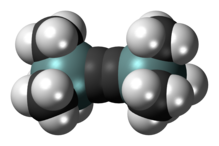Bis(trimethylsilyl)acetylene: Difference between revisions
consistency in formulas |
repair ref |
||
| Line 42: | Line 42: | ||
== Applications == |
== Applications == |
||
BTMSA is used as a [[nucleophile]] in [[Friedel-Crafts reaction|Friedel-Crafts]] type [[acylation]]s and [[alkylation]]s and a precursor to lithium trimethylsilylacetylide. The TMS groups can be removed with [[tetra-n-butylammonium fluoride]] (TBAF) and replaced with protons. BTMSA is also a useful [[reagent]] in [[cycloaddition]] reactions. Illustrating its versatility, BTMSA was used in a concise total synthesis of (±)-[[estrone]].<ref> |
BTMSA is used as a [[nucleophile]] in [[Friedel-Crafts reaction|Friedel-Crafts]] type [[acylation]]s and [[alkylation]]s and a precursor to lithium trimethylsilylacetylide. The TMS groups can be removed with [[tetra-n-butylammonium fluoride]] (TBAF) and replaced with protons. BTMSA is also a useful [[reagent]] in [[cycloaddition]] reactions. Illustrating its versatility, BTMSA was used in a concise total synthesis of (±)-[[estrone]].<ref>{{cite book |doi=10.1002/047084289X.rb209.pub2 |chapter=Bis(trimethylsilyl)acetylene |title=Encyclopedia of Reagents for Organic Synthesis |year=2008 |last1=Curtin |first1=Michael L. |last2=Wang |first2=Cheng |isbn=978-0471936237 }}</ref> A key step in this synthesis was the formation of the steroidal skeleton, catalyzed by [[Cyclopentadienylcobalt dicarbonyl|CpCo(CO)<sub>2</sub>]]. |
||
BTMSA also serves as a [[ligand]] in [[organometallic chemistry]]. For example, it forms stable [[adduct]]s with [[metallocene]]s.<ref>{{cite journal|doi=10.1021/om0208570|title=The Titanocene Complex of Bis(trimethylsilyl)acetylene: Synthesis, Structure, and Chemistry†|year=2003|last1=Rosenthal|first1=Uwe|last2=Burlakov|first2=Vladimir V.|last3=Arndt|first3=Perdita|last4=Baumann|first4=Wolfgang|last5=Spannenberg|first5=Anke|journal=Organometallics|volume=22|issue=5|pages=884–900}}</ref> |
BTMSA also serves as a [[ligand]] in [[organometallic chemistry]]. For example, it forms stable [[adduct]]s with [[metallocene]]s.<ref>{{cite journal|doi=10.1021/om0208570|title=The Titanocene Complex of Bis(trimethylsilyl)acetylene: Synthesis, Structure, and Chemistry†|year=2003|last1=Rosenthal|first1=Uwe|last2=Burlakov|first2=Vladimir V.|last3=Arndt|first3=Perdita|last4=Baumann|first4=Wolfgang|last5=Spannenberg|first5=Anke|journal=Organometallics|volume=22|issue=5|pages=884–900}}</ref> |
||
Revision as of 21:55, 15 June 2023

| |

| |
| Names | |
|---|---|
| Preferred IUPAC name
Ethynediylbis(trimethylsilane) | |
| Other names
BTMSA
| |
| Identifiers | |
3D model (JSmol)
|
|
| ChemSpider | |
| ECHA InfoCard | 100.035.141 |
PubChem CID
|
|
CompTox Dashboard (EPA)
|
|
| |
| |
| Properties | |
| C8H18Si2 | |
| Molar mass | 170.402 g·mol−1 |
| Appearance | Colorless to white Liquid |
| Density | 0.791 g/cm3 |
| Melting point | 26 °C (79 °F; 299 K) |
| Boiling point | 134.6 ± 8.0 °C |
| 0.031 g/L | |
| Hazards | |
| Occupational safety and health (OHS/OSH): | |
Main hazards
|
Flammable, Irritant |
Except where otherwise noted, data are given for materials in their standard state (at 25 °C [77 °F], 100 kPa).
| |
Bis(trimethylsilyl)acetylene (BTMSA) is an organosilicon compound with the formula Me3SiC≡CSiMe3 (Me = methyl). It is a colorless liquid that is soluble in organic solvents. This compound is used as a surrogate for acetylene.
BTMSA is prepared by treating acetylene with butyl lithium followed by addition of chlorotrimethylsilane:[1][2]
- Li2C2 + 2 Me3SiCl → Me3SiC≡CSiMe3 + 2 LiCl
Applications
BTMSA is used as a nucleophile in Friedel-Crafts type acylations and alkylations and a precursor to lithium trimethylsilylacetylide. The TMS groups can be removed with tetra-n-butylammonium fluoride (TBAF) and replaced with protons. BTMSA is also a useful reagent in cycloaddition reactions. Illustrating its versatility, BTMSA was used in a concise total synthesis of (±)-estrone.[3] A key step in this synthesis was the formation of the steroidal skeleton, catalyzed by CpCo(CO)2.
BTMSA also serves as a ligand in organometallic chemistry. For example, it forms stable adducts with metallocenes.[4]
- Cp2TiCl2 + Mg + Me3SiC≡CSiMe3 → Cp2Ti[(CSiMe3)2] + MgCl2
BTMSA is also used in the total synthesis of epibatidine (and analogs), and also in the synthesis of iclaprim.
References
- ^ Holmes, A.; Sporikou, C.; Org. Synth. 1993, Coll. Vol. 8, 606.
- ^ Walton, D.R.M.; Waugh, F. (1972). "Friedel-crafts reactions of bis(trimethylsilyl)polyynes with acyl chlorides; a useful route to terminal-alkynyl ketones". Journal of Organometallic Chemistry. 37: 45–56. doi:10.1016/S0022-328X(00)89260-8.
- ^ Curtin, Michael L.; Wang, Cheng (2008). "Bis(trimethylsilyl)acetylene". Encyclopedia of Reagents for Organic Synthesis. doi:10.1002/047084289X.rb209.pub2. ISBN 978-0471936237.
- ^ Rosenthal, Uwe; Burlakov, Vladimir V.; Arndt, Perdita; Baumann, Wolfgang; Spannenberg, Anke (2003). "The Titanocene Complex of Bis(trimethylsilyl)acetylene: Synthesis, Structure, and Chemistry†". Organometallics. 22 (5): 884–900. doi:10.1021/om0208570.
